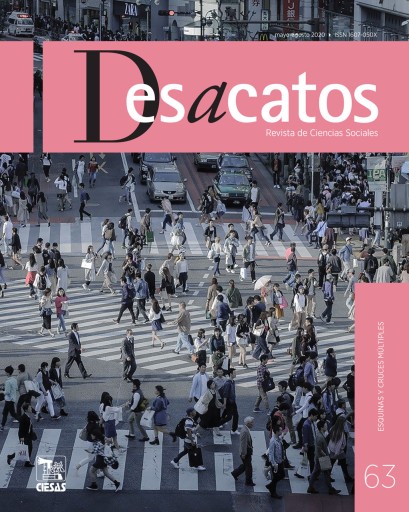Estructura y tipologías de la práctica de lo paranormal: un análisis matemático-formal de sus productos cognitivos
DOI:
https://doi.org/10.29340/63.2259Palabras clave:
brujería, magia, paranormal, sobrenatural, supersticiónResumen
Las prácticas de lo paranormal son un fenómeno universal para el control y el conocimiento de sí mismo, los semejantes y el entorno, en el que el mundo se asume como dependiente de la agencia contraintuitiva y no evidente a los sentidos. Aquí se parte de un análisis racional de las explicaciones que las personas dan a los fenómenos de su vida diaria y se presenta un modelo de los componentes, clases, tipos y formas de lo paranormal. Se analizan las principales tipologías en la materia y se postula un modelo según el cual el núcleo de la práctica paranormal está compuesto por organismo, eventos y conducta, así como sus relaciones funcionales, de lo cual surgen ciertas estructuras. Se encontraron cuatro clases fundamentales, 24 tipos y 12 formas de las prácticas de lo paranormal.Descargas
Los datos de descarga aún no están disponibles.
Referencias
Beck, Jan y Wolfgang Forstmeier, 2007, “Superstition and Belief as Inevitable By-Products of an Adaptive Learning Strategy”, en Human Nature, vol. 18, núm. 1, pp. 35-46. DOI: https://doi.org/10.1007/bf02820845.
Brugger, Peter y Isabelle Viaud-Delmont, 2010, “Superstitiousness in Obsessive-Compulsive Disorder”, en Dialogues in Clinical Neuroscience, vol. 12, núm. 2, pp. 250-254. Disponible en línea: http://www.ncbi.nlm.nih.gov/pmc/articles/PMC3181957/pdf/DialoguesClinNeurosci-12- 250.pdf.
Bruno, Giordano, 2007 [1588; 1590], De la magia. De los vínculos en general, Cactus, Buenos Aires.
Campbell, Colin, 1996, “Half-Belief and the Paradox of Ritual Instrumental Activism: A Theory of Modern Superstition”, en The British Journal of Sociology, vol. 47, núm. 1, pp. 151-166.
Chomsky, Noam, 1965, Aspects of the Theory of Syntax, MIT Press, Cambridge.
————, 1995, The Minimalist Program, MIT Press, Cambridge.
————, 2002, On Nature and Language, Cambridge University Press, Cambridge.
D’Agati, Marina, 2014, “‘I Feel Like I’m Going to Win’: Superstition in Gambling”, en Qualitative Sociology Review, vol. 10, núm. 2, pp. 80-101. Disponible en línea: http://www.qualitativesociologyreview.org/ENG/archive_eng.php.
Dundes, Alan, 1961, “Brown County Superstitions”, en Midwest Folklore, núm. 11, pp. 25-56.
Foster, Kevin y Hanna Kokko, 2009, “The Evolution of Superstitious and Superstition-Like Behaviour”, en Proceedings of the Royal Society, núm. B 276, pp. 31-37. DOI: http://10.1098/rspb.2008.0981.
Frater, U. D., 2005, High Magic: Theory and Practice, Llewellyn, Woodbury.
George, Sonia y Krishna Sreedhar, 2006, “Globalisation and the Prevalence of Superstitious Beliefs”, en Journal of the Indian Academy of Applied Psychology, vol. 32, núm. 3, pp. 241-247. Disponible en línea: <http://medind.nic.in/jak/t06/i1/jakt06i1p241.pdf>.
Greenwood, Susan, 2000, Magic, Witchcraft and the Otherworld, Berg, Oxford.
Jarvis, Peter, 1980, “Towards a Sociological Understanding of Superstition”, en Social Compass, vol. 27, núm. 2-3, pp. 285-295.
Kramer, Heinrich y Jacobus Sprenger, 1996 [1486], Malleus maleficarum, Bracken, Londres.
Leuba, James, 1912, “The Varieties, Classification, and Origin of Magic”, en American Anthropologist, vol. 14, núm. 2, pp. 350-367. Disponible en línea: http://www.jstor.org/stable/659937.
Lindeman, Marjaana y Kia Aarnio, 2007, “Superstitious, Magical, and Paranormal Beliefs: An Integrative Model”, en Journal of Research in Personality, vol. 41, núm. 4, pp. 731-744. DOI: https://10.1016/j.jrp.2006.06.009.
MacIntyre, Alasdair, 1981, After Virtue. A Study in Moral Theory, University of Notre Dame Press, Notre Dame.
Markle, Thomas, 2010, “The Magic that Binds Us: Magical Thinking and Inclusive Fitness”, en Journal of Social, Evolutionary, and Cultural Psychology, vol. 4, núm. 1, pp. 18-33. DOI: https://doi.org/10.1037/h0099304.
Matute, Helena y Miguel Vadillo, 2012, “Causal Learning and Illusions of Control”, en Norbert Seel (ed.), Encyclopedia of the Sciences of Learning, Springer, Berlin, pp. 1-4. Disponible en línea: https://10.1007/SpringerReference_301904.
Melchior-Bonnet, Sabine, 2001, The Mirror. A History, Routledge, Nueva York.
Murray, Margaret, 2006, El dios de los brujos, Fondo de Cultura Económica, México.
Näyhä, Simo, 2002, “Traffic Deaths and Superstition on Friday the 13th”, en American Journal of Psychiatry, vol. 159, núm. 12, pp. 2110-2111. DOI: https://doi.org/10.1176/appi.ajp.159.12.2110.
Oberter, Rachel, 2012, “‘The Sublimation of Matter into Spirit’: Anna Mary Howitt’s Automatic Drawings”, en Sarah Willburn y Tatiana Kontou (eds.), The Ashgate Research Companion to Nineteenth-Century Spiritualism and The Occult, Ashgate Publishing Limited, Surrey, pp. 333-358.
Otto, Bernd-Christian y Michael Stausberg, 2014, “General Introduction”, en Bernd-Christian Otto y Michael Stausberg (eds.), Defining Magic: A Reader, Routledge, Nueva York, pp. 1-13.
Pronin, Emily, Daniel Wegner, Kimberly McCarthy y Sylvia Rodríguez, 2006, “Everyday Magical Powers: The Role of Apparent Mental Causation in the Overestimation of Personal Influence”, en Journal of Personality and Social Psychology, vol. 91, núm. 2, pp. 218–231. DOI: https://doi.org/10.1037/0022-3514.91.2.218.
Sándor, László, 2007, Anglo-Saxon Prognostics, 900-1100. Study and Texts, Brill, Leiden.
Simonds, Laura, James Demetre y Cristina Read, 2009, “Relationships between Magical Thinking, Obsessive-Compulsiveness and Other Forms of Anxiety in a Sample of Non-Clinical Children”, en British Journal of Developmental Psychology, vol. 27, núm. 2, pp. 457-71. DOI: https://doi.org/10.1348/026151008x345582.
Skinner, Burrhus, 1948, “‘Superstition’ in the Pigeon”, en Journal of Experimental Psychology, núm. 38, pp. 168-172. DOI: https://doi.org/10.1037/ h0055873.
Spears, Lauren, 2013, An Examination of Magical Beliefs as Predictors of Obsessive-Compulsive Symptom Dimensions, tesis de doctorado en psicología, University of Kansas. Disponible en línea: https://kuscholarworks.ku.edu/bitstream/handle/1808/16830/Spears_ ku_0099D_12740_DATA_1.pdf?sequence=1.
Stevens, Phillips, 2004, “Divination”, en Frank Salamone (ed.), Encyclopedia of Religious Rites, Rituals, and Festivals, Routledge, Londres, pp. 114-118.
Vadillo, Miguel, Helena Matute y Fernando Blanco, 2013, “Fighting the Illusion of Control: How to Make Use of Cue Competition and Alternative Explanations”, en Universitas Psychologica, vol. 12, núm. 1, pp. 261-270.
Brugger, Peter y Isabelle Viaud-Delmont, 2010, “Superstitiousness in Obsessive-Compulsive Disorder”, en Dialogues in Clinical Neuroscience, vol. 12, núm. 2, pp. 250-254. Disponible en línea: http://www.ncbi.nlm.nih.gov/pmc/articles/PMC3181957/pdf/DialoguesClinNeurosci-12- 250.pdf.
Bruno, Giordano, 2007 [1588; 1590], De la magia. De los vínculos en general, Cactus, Buenos Aires.
Campbell, Colin, 1996, “Half-Belief and the Paradox of Ritual Instrumental Activism: A Theory of Modern Superstition”, en The British Journal of Sociology, vol. 47, núm. 1, pp. 151-166.
Chomsky, Noam, 1965, Aspects of the Theory of Syntax, MIT Press, Cambridge.
————, 1995, The Minimalist Program, MIT Press, Cambridge.
————, 2002, On Nature and Language, Cambridge University Press, Cambridge.
D’Agati, Marina, 2014, “‘I Feel Like I’m Going to Win’: Superstition in Gambling”, en Qualitative Sociology Review, vol. 10, núm. 2, pp. 80-101. Disponible en línea: http://www.qualitativesociologyreview.org/ENG/archive_eng.php.
Dundes, Alan, 1961, “Brown County Superstitions”, en Midwest Folklore, núm. 11, pp. 25-56.
Foster, Kevin y Hanna Kokko, 2009, “The Evolution of Superstitious and Superstition-Like Behaviour”, en Proceedings of the Royal Society, núm. B 276, pp. 31-37. DOI: http://10.1098/rspb.2008.0981.
Frater, U. D., 2005, High Magic: Theory and Practice, Llewellyn, Woodbury.
George, Sonia y Krishna Sreedhar, 2006, “Globalisation and the Prevalence of Superstitious Beliefs”, en Journal of the Indian Academy of Applied Psychology, vol. 32, núm. 3, pp. 241-247. Disponible en línea: <http://medind.nic.in/jak/t06/i1/jakt06i1p241.pdf>.
Greenwood, Susan, 2000, Magic, Witchcraft and the Otherworld, Berg, Oxford.
Jarvis, Peter, 1980, “Towards a Sociological Understanding of Superstition”, en Social Compass, vol. 27, núm. 2-3, pp. 285-295.
Kramer, Heinrich y Jacobus Sprenger, 1996 [1486], Malleus maleficarum, Bracken, Londres.
Leuba, James, 1912, “The Varieties, Classification, and Origin of Magic”, en American Anthropologist, vol. 14, núm. 2, pp. 350-367. Disponible en línea: http://www.jstor.org/stable/659937.
Lindeman, Marjaana y Kia Aarnio, 2007, “Superstitious, Magical, and Paranormal Beliefs: An Integrative Model”, en Journal of Research in Personality, vol. 41, núm. 4, pp. 731-744. DOI: https://10.1016/j.jrp.2006.06.009.
MacIntyre, Alasdair, 1981, After Virtue. A Study in Moral Theory, University of Notre Dame Press, Notre Dame.
Markle, Thomas, 2010, “The Magic that Binds Us: Magical Thinking and Inclusive Fitness”, en Journal of Social, Evolutionary, and Cultural Psychology, vol. 4, núm. 1, pp. 18-33. DOI: https://doi.org/10.1037/h0099304.
Matute, Helena y Miguel Vadillo, 2012, “Causal Learning and Illusions of Control”, en Norbert Seel (ed.), Encyclopedia of the Sciences of Learning, Springer, Berlin, pp. 1-4. Disponible en línea: https://10.1007/SpringerReference_301904.
Melchior-Bonnet, Sabine, 2001, The Mirror. A History, Routledge, Nueva York.
Murray, Margaret, 2006, El dios de los brujos, Fondo de Cultura Económica, México.
Näyhä, Simo, 2002, “Traffic Deaths and Superstition on Friday the 13th”, en American Journal of Psychiatry, vol. 159, núm. 12, pp. 2110-2111. DOI: https://doi.org/10.1176/appi.ajp.159.12.2110.
Oberter, Rachel, 2012, “‘The Sublimation of Matter into Spirit’: Anna Mary Howitt’s Automatic Drawings”, en Sarah Willburn y Tatiana Kontou (eds.), The Ashgate Research Companion to Nineteenth-Century Spiritualism and The Occult, Ashgate Publishing Limited, Surrey, pp. 333-358.
Otto, Bernd-Christian y Michael Stausberg, 2014, “General Introduction”, en Bernd-Christian Otto y Michael Stausberg (eds.), Defining Magic: A Reader, Routledge, Nueva York, pp. 1-13.
Pronin, Emily, Daniel Wegner, Kimberly McCarthy y Sylvia Rodríguez, 2006, “Everyday Magical Powers: The Role of Apparent Mental Causation in the Overestimation of Personal Influence”, en Journal of Personality and Social Psychology, vol. 91, núm. 2, pp. 218–231. DOI: https://doi.org/10.1037/0022-3514.91.2.218.
Sándor, László, 2007, Anglo-Saxon Prognostics, 900-1100. Study and Texts, Brill, Leiden.
Simonds, Laura, James Demetre y Cristina Read, 2009, “Relationships between Magical Thinking, Obsessive-Compulsiveness and Other Forms of Anxiety in a Sample of Non-Clinical Children”, en British Journal of Developmental Psychology, vol. 27, núm. 2, pp. 457-71. DOI: https://doi.org/10.1348/026151008x345582.
Skinner, Burrhus, 1948, “‘Superstition’ in the Pigeon”, en Journal of Experimental Psychology, núm. 38, pp. 168-172. DOI: https://doi.org/10.1037/ h0055873.
Spears, Lauren, 2013, An Examination of Magical Beliefs as Predictors of Obsessive-Compulsive Symptom Dimensions, tesis de doctorado en psicología, University of Kansas. Disponible en línea: https://kuscholarworks.ku.edu/bitstream/handle/1808/16830/Spears_ ku_0099D_12740_DATA_1.pdf?sequence=1.
Stevens, Phillips, 2004, “Divination”, en Frank Salamone (ed.), Encyclopedia of Religious Rites, Rituals, and Festivals, Routledge, Londres, pp. 114-118.
Vadillo, Miguel, Helena Matute y Fernando Blanco, 2013, “Fighting the Illusion of Control: How to Make Use of Cue Competition and Alternative Explanations”, en Universitas Psychologica, vol. 12, núm. 1, pp. 261-270.
Publicado
2020-06-23
Número
Sección
ESQUINAS
Licencia
.
Cómo citar
Estructura y tipologías de la práctica de lo paranormal: un análisis matemático-formal de sus productos cognitivos. (2020). Desacatos. Revista De Ciencias Sociales, 63, 86-103. https://doi.org/10.29340/63.2259


 Enviar un artículo
Enviar un artículo
 Idioma
Idioma
 Información
Información

 Palabras clave
Palabras clave Redes sociales
Redes sociales